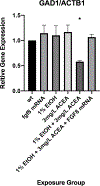Ethanol and Cannabinoids Regulate Zebrafish GABAergic Neuron Development and Behavior in a Sonic Hedgehog and Fibroblast Growth Factor-Dependent Mechanism
- PMID: 32472575
- PMCID: PMC7572643
- DOI: 10.1111/acer.14383
Ethanol and Cannabinoids Regulate Zebrafish GABAergic Neuron Development and Behavior in a Sonic Hedgehog and Fibroblast Growth Factor-Dependent Mechanism
Abstract
Background: Ethanol (EtOH) has diverse effects on nervous system development, which includes development and survival of GABAergic neurons in a sonic hedgehog (Shh) and fibroblast growth factor (Fgf)-dependent mechanism. Cannabinoids also function as inhibitors of Shh signaling, raising the possibility that EtOH and cannabinoids may interact to broadly disrupt neuronal function during brain development.
Methods: Zebrafish embryos were exposed to a range of EtOH and/or cannabinoid receptor 1 (CB1R) agonist concentrations at specific developmental stages, in the absence or presence of morpholino oligonucleotides that disrupt shh expression. In situ hybridization was employed to analyze glutamic acid decarboxylase (gad1) gene expression as a marker of GABAergic neuron differentiation, and zebrafish behavior was analyzed using the novel tank diving test as a measure of risk-taking behavior.
Results: Combined acute subthreshold EtOH and CB1R agonist exposure results in a marked reduction in gad1 mRNA expression in zebrafish forebrain. Consistent with the EtOH and cannabinoid effects on Shh signaling, fgf8 mRNA overexpression rescues the EtOH- and cannabinoid-induced decrease in gad1 gene expression and also prevents the changes in behavior induced by EtOH and cannabinoids.
Conclusions: These studies provide evidence that forebrain GABAergic neuron development and zebrafish risk-taking behavior are sensitive to both EtOH and cannabinoid exposure in a Shh- and Fgf-dependent mechanism, and provide additional evidence that a signaling pathway involving Shh and Fgf crosstalk is a critical target of EtOH and cannabinoids in FASD.
Keywords: Cannabinoid; FASD; Fgf; Shh; gad1.
© 2020 by the Research Society on Alcoholism.
Conflict of interest statement
The authors have no conflicts of interest to report.
Figures










Similar articles
-
Forebrain and hindbrain development in zebrafish is sensitive to ethanol exposure involving agrin, Fgf, and sonic hedgehog function.Birth Defects Res A Clin Mol Teratol. 2013 Jan;97(1):8-27. doi: 10.1002/bdra.23099. Epub 2012 Nov 27. Birth Defects Res A Clin Mol Teratol. 2013. PMID: 23184466 Free PMC article.
-
Embryonic Ethanol but Not Cannabinoid Exposure Affects Zebrafish Cardiac Development via Agrin and Sonic Hedgehog Interaction.Cells. 2023 May 6;12(9):1327. doi: 10.3390/cells12091327. Cells. 2023. PMID: 37174727 Free PMC article.
-
Ethanol and cannabinoids interact to alter behavior in a zebrafish fetal alcohol spectrum disorder model.Birth Defects Res. 2019 Jul 15;111(12):775-788. doi: 10.1002/bdr2.1458. Epub 2019 Jan 16. Birth Defects Res. 2019. PMID: 30648819
-
Ethanol Effects on Early Developmental Stages Studied Using the Zebrafish.Biomedicines. 2022 Oct 13;10(10):2555. doi: 10.3390/biomedicines10102555. Biomedicines. 2022. PMID: 36289818 Free PMC article. Review.
-
Sonic hedgehog signaling in astrocytes.Cell Mol Life Sci. 2021 Feb;78(4):1393-1403. doi: 10.1007/s00018-020-03668-8. Epub 2020 Oct 20. Cell Mol Life Sci. 2021. PMID: 33079226 Free PMC article. Review.
Cited by
-
Roots of the Malformations of Cortical Development in the Cell Biology of Neural Progenitor Cells.Front Neurosci. 2022 Jan 5;15:817218. doi: 10.3389/fnins.2021.817218. eCollection 2021. Front Neurosci. 2022. PMID: 35069108 Free PMC article. Review.
-
Multifactorial Genetic and Environmental Hedgehog Pathway Disruption Sensitizes Embryos to Alcohol-Induced Craniofacial Defects.Alcohol Clin Exp Res. 2020 Oct;44(10):1988-1996. doi: 10.1111/acer.14427. Epub 2020 Aug 30. Alcohol Clin Exp Res. 2020. PMID: 32767777 Free PMC article.
-
Neurochemical and Behavioral Consequences of Ethanol and/or Caffeine Exposure: Effects in Zebrafish and Rodents.Curr Neuropharmacol. 2022 Mar 4;20(3):560-578. doi: 10.2174/1570159X19666211111142027. Curr Neuropharmacol. 2022. PMID: 34766897 Free PMC article. Review.
-
Reduced fetal cerebral blood flow predicts perinatal mortality in a mouse model of prenatal alcohol and cannabinoid exposure.BMC Pregnancy Childbirth. 2024 Apr 11;24(1):263. doi: 10.1186/s12884-024-06436-9. BMC Pregnancy Childbirth. 2024. PMID: 38605299 Free PMC article.
-
Perturbation of 3D nuclear architecture, epigenomic dysregulation and aging, and cannabinoid synaptopathy reconfigures conceptualization of cannabinoid pathophysiology: part 1-aging and epigenomics.Front Psychiatry. 2023 Sep 5;14:1182535. doi: 10.3389/fpsyt.2023.1182535. eCollection 2023. Front Psychiatry. 2023. PMID: 37732074 Free PMC article. Review.
References
-
- Aoto K, Shikata Y, Higashiyama D, Shiota K, Motoyama J (2008) Fetal ethanol exposure activates protein kinase A and impairs Shh expression in prechordal mesendoderm cells in the pathogenesis of holoprosencephaly. Birth Defects Res (Part A) 82: 224–231. - PubMed
-
- Boa-Amponsem O, Zhang C, Mukhopadhyay S, Ardrey A, Cole GJ (2019) Ethanol and cannabinoids interact to alter behavior in a zebrafish fetal alcohol spectrum disorder model. Birth Defects Research 1–14. - PubMed
Publication types
MeSH terms
Substances
Grants and funding
LinkOut - more resources
Full Text Sources
Molecular Biology Databases

